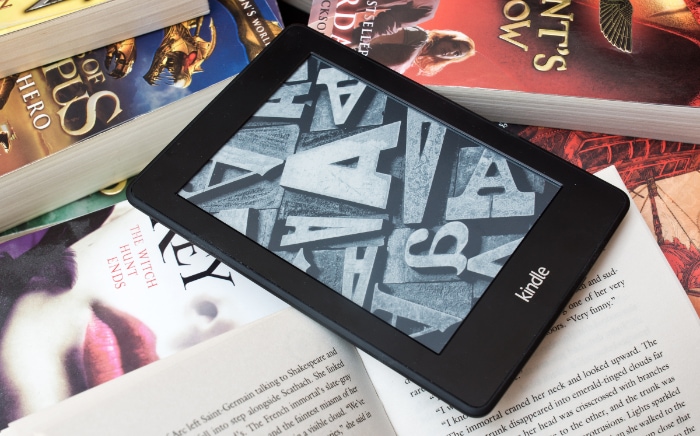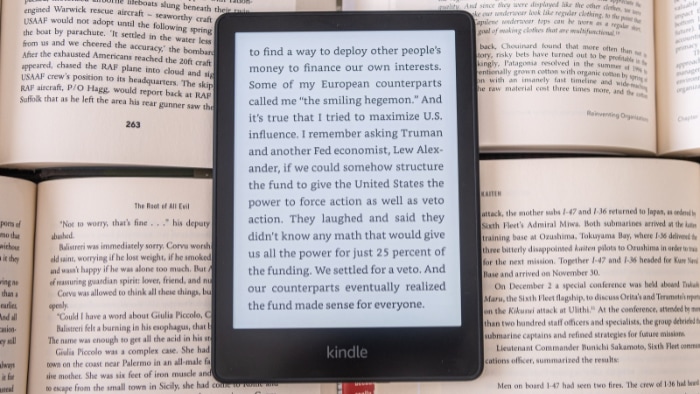Kindle vs. Physical Books: A Reader’s Dilemma

As technology continues to permeate every facet of our lives, the debate between embracing digital innovation and holding onto traditional methods rages on. One such area of contention is the world of reading. Amazon’s Kindle, a pioneering e-reader, has made a significant mark, offering convenience and an expansive digital library in the palm of your hand.
On the other hand, with their tactile appeal and centuries-old history, physical books remain a beloved choice for many.
Brief History
The story of books is a testament to human civilization’s love for knowledge and stories. As we journey through the ages, from hand-written manuscripts to the e-readers of today, we witness an evolution in the way we consume content.
The Rise of Physical Books
Long before the invention of the printing press, stories and knowledge were preserved and passed down through oral traditions. However, as societies advanced, there arose a need to document and share this knowledge more widely.
This led to the creation of hand-written manuscripts, meticulously crafted by scribes and often adorned with beautiful illustrations.
By the 15th century, a groundbreaking invention changed the course of history. Johannes Gutenberg introduced the printing press to Europe, and with it came the mass production of books.
This not only made books more accessible to the general public but also catalyzed the spread of knowledge and ideas. Over time, the love for books grew, leading to the establishment of public libraries, book clubs, and literary festivals, firmly embedding physical books into the fabric of human culture.
Emergence of E-Readers and Kindle’s Debut
As the 20th century drew to a close, technological advancements began to influence almost every aspect of our lives. The realm of reading was no exception.
The late 1990s and early 2000s saw the first attempts at creating electronic books, or e-books, aiming to digitize the reading experience.
Amazon, recognizing the potential in this new medium, introduced the Kindle in 2007. It was more than just an e-reader; it was a platform that allowed users instant access to a vast digital library.
The convenience of having multiple books stored in one compact device appealed to many, especially frequent travelers and those with limited physical space. Over the years, the Kindle underwent several refinements, from improved battery life to enhanced display technology, ensuring a more comfortable reading experience.
The Continuing Journey
While the Kindle and other e-readers have carved out a significant niche, physical books remain steadfast in their popularity. Both forms have their loyalists, and the choice often boils down to personal preference.
As technology and tradition continue to intertwine, the narrative of books is still being written in all their forms.
Advantages of Kindle
In an age where convenience and technology reign supreme, the Kindle has emerged as a favorite among many readers. As with any technological advancement, it comes with a set of distinct advantages tailored to the modern individual’s lifestyle and needs.
Portability and Storage
Imagine carrying an entire library in your backpack or even your pocket. The Kindle makes this possible. With its compact design, it offers readers the ability to store thousands of books in one device.
Gone are the days of deciding which book to bring on a trip or lamenting over limited shelf space at home. With the Kindle, your collection travels with you, always within arm’s reach.
Customization for the Reader
Reading comfort is subjective. What works for one person might not work for another. The Kindle understands this.
Readers can adjust text size, choose different fonts, and even alter the background color to create a reading experience that’s uniquely theirs. For those reading in varying light conditions, the screen brightness can also be modified to reduce eye strain.
Instant Access to New Reads
The thrill of starting a new book is unparalleled. With the Kindle, this excitement is just a click away.
The integrated online store allows users to browse, purchase, and download books within minutes. Whether it’s a new release or a classic, the vast digital library ensures that readers are never short of options.
Interactive Features Enhance the Experience
Beyond mere reading, the Kindle offers tools that enrich the learning and comprehension process. Highlighting key passages, making notes, and even referring to a built-in dictionary can be done effortlessly.
For those curious about the context, the X-Ray feature provides insights into the book’s characters, terms, and even historical events.
An Eco-friendly Choice
In an era where environmental concerns are paramount, choosing a Kindle can be seen as a step towards sustainability. Reducing the need for paper and physical distribution means fewer trees are cut down, and there’s a decrease in the carbon footprint associated with transporting books.
While the joy of reading remains constant, the Kindle provides a fresh approach, blending tradition with technology to cater to the dynamic needs of today’s readers.
Advantages of Physical Books

While the digital age has introduced innovative ways to consume content, the allure of physical books remains timeless. These tangible treasures offer a unique set of benefits that resonate deeply with many readers, celebrating the age-old tradition of holding a story in one’s hands.
A Tangible Experience
There’s an undeniable charm in feeling the weight of a book, turning its pages, and smelling the familiar scent of paper. The sensory experience of reading a physical book is unparalleled. For many, it’s a ritual – the act of choosing a book from a shelf, finding a cozy reading spot, and getting lost in its pages.
Battery-Free Reading
In a world dominated by devices that require charging, physical books stand apart. They are always ready to be read, with no concerns about battery life.
Whether it’s during a power outage or on a long journey without access to charging ports, physical books prove their reliability time and again.
Building Personal Libraries
Over the years, avid readers often accumulate books, creating personal libraries that reflect their tastes, interests, and reading journey. These collections become a point of pride, serving not just as a repository of knowledge but also as decor, adding character to living spaces.
Moreover, the spine of each book on a shelf tells a story, offering a glimpse into the reader’s world.
Lending, Reselling, and Sharing
Physical books can easily be lent to friends or family, allowing stories and knowledge to be shared. Once done, books can be donated to local libraries, sold in second-hand bookstores, or even swapped in book exchange clubs.
This cycle gives books multiple lives and offers readers diverse reading experiences without the need for new purchases.
Personal Annotations and Memories
Jotting down thoughts, underlining favorite quotes, or placing a memorable bookmark within the pages of a book adds a personal touch. Over time, these annotations become memories, transforming books into diaries of sorts, capturing moments from the reader’s life.
Embracing the tangible and the authentic, physical books offer a personal and profound experience. In a rapidly evolving world, they stand as a testament to the enduring power of stories and the simple joys of reading.
Considerations in the Debate
The discussion surrounding Kindles versus physical books isn’t simply black and white. It’s a layered conversation, with numerous aspects to consider. Let’s explore some of these facets to understand the broader implications of this debate.
Cost Implications
The financial aspect of reading cannot be overlooked. Purchasing a Kindle requires an initial investment, but once owned, e-books often come at a fraction of the cost of their physical counterparts.
On the flip side, while physical books might have a higher individual cost, there’s no initial device investment. Additionally, physical books can be bought at discounted rates from second-hand stores or borrowed from libraries.
Eye Comfort and Health
Reading on a backlit screen for extended periods can strain the eyes for some individuals. While modern e-readers like Kindle have developed screens that mimic the appearance of printed text, there’s still a difference between looking at a screen and a printed page.
Physical books, being devoid of any screen, might provide a more comfortable reading experience for many.
Durability and Longevity
Electronic devices, even with the best care, have a finite lifespan. They can malfunction, get damaged, or become obsolete with newer technology.
Physical books, if cared for properly, can last for generations. While they are susceptible to wear and tear, there’s no risk of system crashes or lost files.
Supporting Authors and Publishers
The revenue models for e-books and physical books differ. Some argue that buying physical copies better supports authors and publishers due to the traditional pricing and distribution model.
However, the rise of e-books has also allowed many indie authors to publish their works without going through traditional publishing houses, democratizing the process.
Emotional and Sentimental Value
Books are more than just vessels of information or stories for many readers. They carry memories, emotions, and histories. Gifting a physical book, for instance, has a sentimental value that’s hard to replicate with a digital download.
Physical books can be treasured, passed down, and even become family heirlooms.
Ease of Sharing and Distribution
E-books, especially those with DRM protections, can be restrictive in terms of sharing. Physical books have no such constraints.
They can be easily lent, gifted, or donated, making them more versatile in terms of distribution among multiple readers.
In this ever-evolving discussion, personal preferences play a significant role. By weighing these considerations, readers can make informed decisions that cater to their needs, preferences, and values.
The Middle Ground

While the debate between Kindle and physical books may seem polarized, many readers find solace in a middle ground, harnessing the strengths of both mediums. Balancing tradition with innovation, this approach offers a comprehensive reading experience tailored to diverse situations and needs.
Hybrid Libraries
For the voracious reader, a hybrid library might be the perfect solution. This entails maintaining a collection of both e-books and physical copies.
While digital versions are ideal for traveling or when on-the-go, physical books serve as mainstays at home, creating a sanctuary for immersive reading sessions.
Addressing Different Reading Purposes
The choice between digital and physical can also depend on the purpose of reading. For instance, academic or reference books, which might require quick searches and annotations, can be more practical in digital format.
In contrast, leisurely reads, especially cherished classics or collector’s editions, might be preferred in physical form.
Gifting and Collecting
While e-books offer convenience, physical books are often chosen for gifting, adding that personal touch to presents. Moreover, bibliophiles might choose to collect physical editions of their favorite authors or series, showcasing them prominently on bookshelves, even if they read across both formats.
Exploring Subscription Models
Services like Kindle Unlimited or Audible provide a vast array of digital books for a monthly fee. Meanwhile, joining a local library can give readers access to many physical books.
By combining these options, one can enjoy a wide variety of content without committing to a singular format.
Embracing Eco-conscious Choices
For the environmentally conscious, the middle ground can also involve making choices that reduce one’s carbon footprint. This might mean opting for e-books in many cases but choosing physical books made from sustainable or recycled materials when the tangible touch is desired.
Flexibility in Consumption
With technology integrating audiobooks and text-to-speech features, readers aren’t confined to traditional reading alone. One could start a book on their Kindle, switch to an audiobook version during a commute, and return to a physical copy at bedtime.
This fluidity caters to the modern multitasker, ensuring stories and knowledge remain accessible at all times.
By embracing the middle ground, readers acknowledge that there isn’t a one-size-fits-all answer. It’s a celebration of choice, adapting to individual circumstances and moods, and cherishing the act of reading in all its diverse forms.
Conclusion
Both Kindles and physical books offer distinctive experiences and benefits. From the tactile allure of flipping through pages to the convenience of a digital library at one’s fingertips, each medium appeals to different reader preferences and situations.
While the debate might persist, what remains clear is the shared passion for reading, irrespective of the format. By recognizing the strengths of each option and sometimes blending them, readers can craft a reading journey that resonates most deeply with their personal needs and desires.
After all, it’s not about the medium but the joy of discovering stories and expanding one’s horizons.


